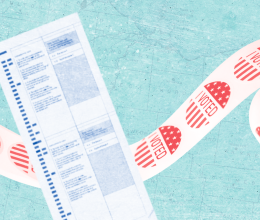To Chairman Plummer, Vice Chair Hillyer, Ranking Member Russo, and members of the House Constitutional Resolutions Committee, thank you for this opportunity to provide opponent testimony on Senate Joint Resolution 2.
The ACLU of Ohio opposes SJR 2 for the simple reason supporters have not offered any compelling reasons to change Ohio’s current ballot initiative process and law.
To be clear, we do not think effective arguments exist to be made for such sudden and radical changes. Ohio’s current ballot initiative process is burdensome and expensive. Should a campaign qualify for the ballot, the process becomes even more complex and expensive, with Ohio’s robust mix of urban, suburban, and rural audiences and locations, and local media markets spread across the state.
All this is precisely why few embark on attempts to change law and policy via the current ballot initiative process and why fewer than that ultimately succeed.
However, SJR 2 purports Ohioans have too much ability to direct their rights and realities and seeks the following, additional restrictions:
- Changing the voter threshold for ballot initiative approval from 50% +1 of voters to at least 60%;
- Changing the amount of required signatures to place a matter on the ballot from at least 5% of all voters (in the most recent governor election) in 44 counties to at least 5% in all 88 counties;
- Eliminating the 10-day “cure” period whereby those submitting signatures for ballot initiatives can submit additional signatures, if needed, when they fall below the required number because of rejected signatures.
As happens so often over the years with voting bills before the General Assembly, proponents point to other states with less freedom and more restrictions as states to idolize and as a reason to change Ohio law to make us equally bad, if not far worse, than any number of our 49 counterparts. Indeed, this “justification” has arose regarding SJR 2 and HJR 1. As if there is an inherent problem should Ohio someday dare lead the nation, or be among the leaders, in empowering its people on matters they want to address or change.
Anyone who has worked on a ballot initiative campaign at virtually any level knows the most burdensome requirement is the aforementioned signature requirement applicable to 44 of Ohio’s 88 counties. Anyone who says the current process is too easy, or does not demonstrate enough support, has never tried to track down signatures on a rainy Tuesday in a Preble County Walmart parking lot.
Requiring potentially hundreds of thousands more votes is bad enough. Eliminating the cure period in a state where many often move residences and are unnecessarily purged from voter rolls is even worse. But the switch from 44 to all 88 counties guarantees the only campaigns that will qualify for the ballot are the most extremely rich ones.
Of course, this is totally contrary to supporters’ contentions SJR 2 somehow protects against well-heeled, out-of-state “special interests.” Those same out-of-state special interests that are welcome to donate money to political campaigns and political parties, lobby legislators, and draft legislation but now must be stopped. Or at least stopped from fully supporting ballot initiatives SJR 2 supporters oppose.
That is the heart of the SJR 2 (and HJR 1, HB 144 and SB 92) matter - ballot initiatives some legislators personally oppose. Soda taxes, casinos, former House speakers, monopolies, and evil special interests are among the list of reasons supporters have cooked up to argue SJR 2 is necessary. But Ohioans know, and very few supporters are left pretending, this involves anything but abortion and gerrymandering.
SJR 2 is a terribly unfair and undemocratic proposal on its best day. On all the other days, it is a rapid, reckless attempt by politicians to seize direct power from Ohio’s people and make them hostages to, instead of welcome participants in, the direction of our state. Especially when abortion rights and legislative districts are in play.
Members of this committee, the ACLU of Ohio urges your rejection of Senate Joint Resolution 2.





